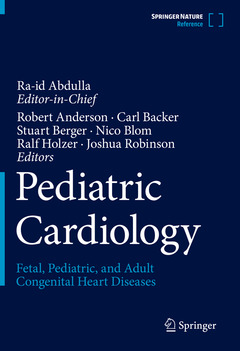Description
Pediatric Cardiology, 2024
Fetal, Pediatric, and Adult Congenital Heart Diseases
Coordinators: Anderson Robert, Backer Carl, Berger Stuart, Blom Nico, Holzer Ralf, Robinson Joshua
Editor-in-Chief: Abdulla Ra-id
Language: English
Subjects for Pediatric Cardiology:
Keywords
Adult congenital heart disease; Congenital heart disease; Fetal cardiology; Fetal heart disease; Heart diseases in children; Medical and surgical treatments for congenital heart disease; Pediatric acquired heart disease; Pediatric cardiology; Pediatric congenital heart disease; Pharmacology and congenital heart disease
2953 p. · 17.8x25.4 cm · Hardback
Description
/li>Contents
/li>Biography
/li>Comment
/li>
This reference work aims to be the primary resource in the field of heart disease in children and adult congenital heart disease. It contains nearly 100 chapters covering all aspects of heart disease in three populations: fetus with acquired and congenital heart diseases, children with acquired and congenital heart diseases, and adults with congenital heart diseases.
Divided into five main sections, the book provides a comprehensive, up-to-date, and continuously revised overview of what is known in the field as well as resources for practical use such as normal values, medication information, and review of published guidelines. The first section of the book includes historical background on congenital heart disease and the evolution of medical, surgical, and catheter therapeutics. The fetal heart disease section comes next and covers cardiovascular embryogenesis, etiological mechanisms, diagnostic tools, presentation and management, cardiomyopathies, arrhythmias, perinatal management, and emergencies. The bulk of the book lies in the third section on pediatric cardiology, which examines not only basic science, assessment, and therapies but also a wide variety of specific acquired and congenital diseases such as valvular lesions, arterial diseases, cyanotic heart diseases, cardiomyopathies, cardiac tumors, and pulmonary hypertension. This is followed by the section on adult congenital heart diseases, discussing echocardiography, electrophysiology, neurodevelopment, and a variety of unique aspects of congenital heart disease in the adult years. The final section of the book focuses on pharmacology with chapters on inotropes, vasopressors, diuretics, and more.
Pediatric Cardiology: Fetal and Pediatric Heart Diseases & Adult Congenital Heart Diseases is an essential reference for physicians, residents, fellows, medical students, nurse-practitioners, and allied health professionals in cardiology, pediatrics, cardiac surgery, and imaging/radiology.
Part I. Historical Perspective.- Evolution of a Science 1. Recognizing congenital heart disease.- 2. History of understanding pathology and hemodynamics of congenital heart disease.- 3. Evolution of medical, surgical, and catheter therapeutics.- Part II. Fetal Cardiology.- Cardiovascular Embryogenesis4. Embryological development of the cardiovascular system.- 5. Normal development of the cardiovascular system.- 6. Mechanisms of abnormal development of the cardiovascular system.- Etiological Mechanisms of Congenital Heart Disease7. Genetics.- 8. Environmental factors.- Diagnostic Tools in Managing Fetal Heart Diseases9. Fetal obstetrical ultrasound.- 10. Fetal echocardiography.- 11. Fetal magnetocardiography.- 12. Other imaging modalities.- Fetal Congenital Heart Diseases: Presentation and Management13. Shunt lesions.- 14. Obstructive lesions.- 15. Anomalies of the great vessels.- 16. Single ventricle and heterotaxy.- 17. Valvar lesions.- Fetal Cardiomyopathies18. Dilated cardiomyopathy.- 19. Hypertrophic cardiomyopathy.- Fetal Arrhythmia: Diagnosis and Management20. Bradyarrhythmia.- 21. Tachyarrhythmia.- 22. Premature beats.- Perinatal Management of Fetal Heart Diseases23. Assessment of the fetus with congenital heart disease.- 24. Multidisciplinary approach.- 25. Counseling for fetal heart disease.- Emergencies in Fetal Cardiology26. Primary heart failure.- 27. Secondary heart failure.- Part III. Pediatric CardiologyBasic Sciences of the Cardiovascular System28. Cardiovascular Anatomy.- 29. Cardiovascular Physiology.- 30. Electrophysiology .- Assessment of the Cardiovascular System31. History and physical examination.- 32. Diagnostic tools.- 33. Chest x-ray.- 34. ECG.- 35. Echocardiography.- 36. Diagnostic cardiac catheterization.- 37. CT scan and MRI.- 38. Exercise stress test.- Therapeutic Tools39. Interventional cardiac catheterization.- 40. Peripheral vascular intervention.- 41. Lymphatic intervention.- Congenital Heart DiseasesShunt Lesions42. Atrial septal defects.- 43. Atrioventricular septal defects.- 44. Ventricular septal defects.- 45. Arterial shunts.- Valvular Lesions 46. Tricuspid valve lesions.- 47. Mitral valve lesions.- 48. Pulmonary valve lesions.- 49. Aortic valve lesions.- Cyanotic Heart Diseases50. Right heart lesions.- 51. Left heart lesions.- 52. Single ventricle.- 53. Great vessel lesions.- Arterial Diseases54. Coarctation of aorta.- 55. Interrupted aortic arch.- 56. Vascular ring.- Systemic Venous Lesions57. Superior vena cava lesions.- 58. Inferior vena cava lesions.- 59. Coronary sinus lesions.- Pulmonary Venous Lesions60. Partial anomalous pulmonary venous return.- 61. Total anomalous pulmonary venous return.- 62. Pulmonary stenosis.- Coronary Artery Lesions63. Anomalous origin of coronary arteries from opposite sinus.- 64. Anomalous origin of left coronary artery from pulmonary artery.- Acquired Heart Diseases Cardiomyopathies 65. Dilated cardiomyopathy.- 66. Hypertrophic cardiomyopathy.- 67. Restrictive cardiomyopathy.- Inflammatory and Autoimmune Diseases Affecting Cardiovascular Disease68. Kawasaki Disease.- 69. Rheumatic fever.- 70. Infective endocarditis.- 71. Pericarditis .- Adult Type Heart Diseases in the Pediatric Age 72. Ischemic Heart Disease.- 73. Lipid disorders.- Cardiac Tumors74. Benign tumors.- 75. Malignant tumors.- 76. Extracardiac masses.- Cardiac Trauma77.Cardiac trauma.- Pulmonary Hypertension78.- Pulmonary hypertension in the neonate.- 79. Pulmonary hypertension secondary to heart disease.- Part IV. Adult Congenital Heart Disease.- 80. Echocardiography.- 81. Cardiac catheterization.- 82. Electrophysiology.- 83. Unique aspects of congenital heart disease in the adult years.- 84. Shunt lesions.- 85. Obstructive lesions.- 86. Valvar lesions.- 87. Single ventricle.- 88. Maternal Heart Diseases.- 89. Neurodevelopment and Quality of Life in adults with congenital heart diseases.- Part V. Pharmacology.- 90. Inotropes.- 91. Afterload reducing agents.- 92. Vasopressors.- 93. Diuretics.- 94. Antiarrhythmic agents.- 95. Resuscitation agents.
Ra-id Abdulla, MD
Professor of Pediatrics, Northwestern University
Editor-in-Chief, Pediatric Cardiology
Stuart Berger, MD
Professor of Pediatrics, Northwestern University
Carl Backer, MD
Professor of Surgery, Northwestern University
Robert Anderson, MD
Professor, King College, UK
Ralf Holzer, MD
Professor of Clinical Pediatrics, Weill Cornell Medical College, Cornell University
Nico Blom, MD
Professor, University of Amsterdam
Joshua Robinson, MD
Associate Professor of Pediatrics, Northwestern University




